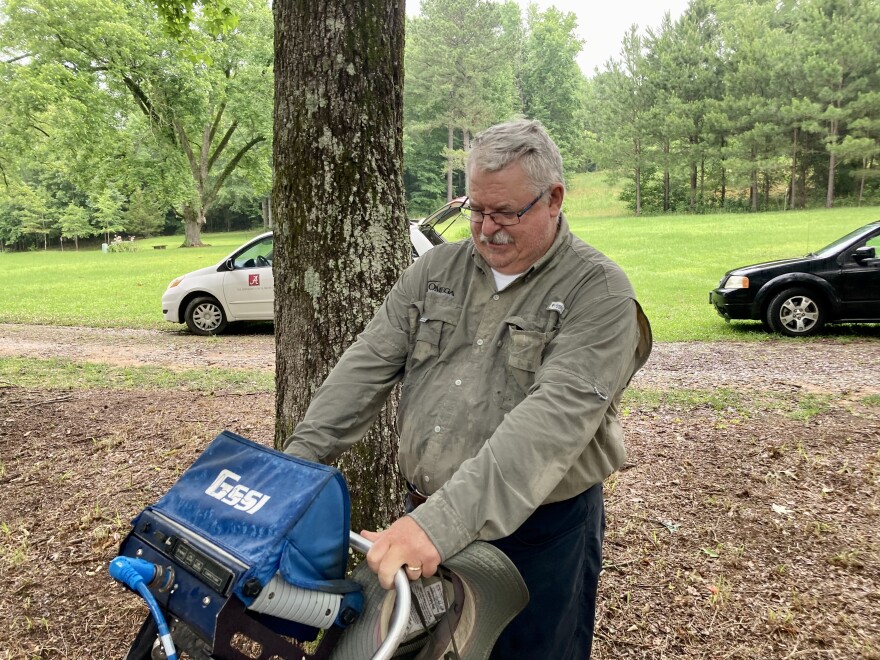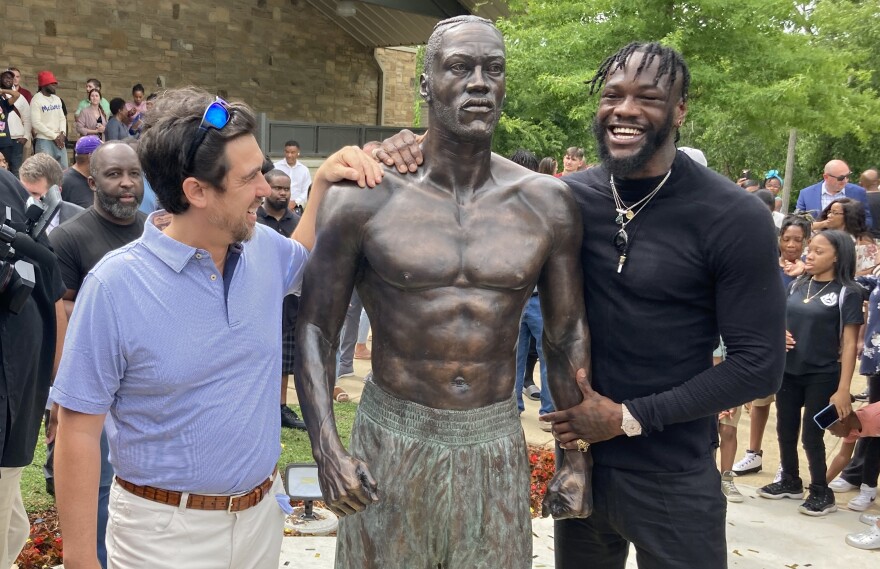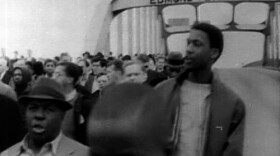Part 2— "The champ, and the slaveholder"
Before the Civil War, the state of Alabama was home to an estimated thirty three thousand slave holders. Local historians say one of them was John Welch Prewitt. He set aside two acres that became known as the Old Prewitt Slave Cemetery. The site may hold up to two hundred unmarked graves. APR news has spent the past eight months investigating efforts to find and preserve slave cemeteries like Old Prewitt. In part two of our series, the story of John Welch Prewitt is still making the rounds. We find how one man heard about it.

“It’s on the crest of a hill, typically that’s where the burials begin and then they evolve away from that,” observed Len Strozier.
A gentle rain was falling at the Old Prewitt Slave Cemetery in Northport, Alabama when we met him. Strozier runs Omega Mapping Services in the town of Fortson, Georgia.
“But, there’s a lot of them I can see,” he said.
That assessment came after a scan with Ground Penetrating Radar that looks underground. APR news invited him to survey Old Prewitt. It didn’t take long to get results.
“In less than thirty minutes, forty. Just walking around. I’ve seen forty burials out here,” said Strozier.
The only sound during our visit was the rain, the beep from Strozier’s radar gear, and the occasional slap when the morning mosquitoes came calling. Things were a bit more raucous thirteen miles to the south
The parking lot at the Tuscaloosa Tourism and Sports Commission is especially busy today. Onlookers form a ring around a life sized bronze statue, still covered with a black tarp. The chatter seems divided between the art work and the man who posed for it.

Former world heavyweight boxing champion Deontay Wilder is from Tuscaloosa. He still lives here. Wilder made the rounds in the VIP room just before a statue in his honor was to be unveiled. Some fans talked about his five years as champ. Others focused on his ninety three percent knockout rate. APR news was there for something else.
“To go down there, you can like feel the energy and the power of it,” said Wilder.
During a quiet moment, Wilder talked about visiting the Old Prewitt Slave Cemetery. It wasn’t a long trip. Wilder lives almost next door to the burial site. He says he didn’t know about it when he moved in his new home in Northport. But, he soon did.
“You know how when you move into an area, and the neighbors come and greet you with pies and cakes,” said Wilder.
Instead of dessert, Wilder’s neighbors brought something else
“For me, I got greeted with important information. I got greeted with historic information and stuff like that,” recalled Wilder.

That included stories about the cemetery set up in the 1820's by Civil War plantation owner John Welch Prewitt.
“It’s amazing to know that I have an untended graveyard, I literally mean on the side of me. It doesn’t spook me out or nothing like that,” he said.
“I don't know that a whole lot else stands out about him as except as a slave holder and a plantation owner,” said Doctor Joshua Rothman, of John Welch Prewitt. “Other than that, he's a very wealthy man and kind of the late antebellum period.”
Rothman is head of the history department at the University of Alabama. His area of expertise is slavery. And, he’s heard his share of stories about Prewitt, including the whoppers.
“So the two that I've heard the most are that he enslaved 1000 people, and was the biggest slave holder in Tuscaloosa County. And there's another story about there being like bars of gold buried on his property,” recalled Rothman.
Rothman says he’s not sure one way or the other about the gold, but the slave count was more like one hundred and fifty, not a thousand.
“What's weird is that it's a story people told them they like, but you can look at the census. And you can see it's not true,” he said.
And if that’s not enough…
“There’s also the tale of a ghost walking on the site of the former home of Mr. and Mrs. John W. Prewitt,” read Allison Hetzel, of the University of Alabama’s Theatre Department. This story comes from the Alabama state archives. It’s from a folder marked “negro folklore.”

"Mrs. Prewitt, affectionately known as “Miss Betsy,” by the negroes, would visit the cabins with simple remedies when any of the slaves were ailing. It is claimed that Miss Betsy still walks on rainy nights, basket on arm. That story being shared by many of the better educated white farmers,” read Hetzell.
“If you tell yourself that story, and you genuinely believe it, then what is there to feel guilty about?” suggested Joshua Rothman.
“It's not a secret, for example, that there are a lot of stories that are have been told by white Southerners, over the course of many generations, trying to make slavery seem far less bad. And that's a very different kind of story than descendants of enslaved people are likely to tell,” he said.
And telling that story can be difficult. That’s because whites also kept the records. For the families and volunteers trying to preserve slave cemeteries or find the graves of lost relatives, that’s often where the trail goes cold.

Back at the Tuscaloosa Tourism and Sports commission, everybody crowds around for the unveiling of Deontay Wilder’s statue…
“It was a treat,” said the champ. Wilder wasn’t referring to letting the crowd see his statue. But, rather the powerful experience of visiting the Old Prewitt Slave Cemetery.
“To understand and know where you are, and what you’re setting your feet on, and what occurred in certain times of the years, that you don’t nothing about,” Wilder said.
Wilder says he’s also ready to help out when it comes preserving Old Prewitt. Not everyone can call on a celebrity to do that. Most of the work to rescue slave burial sites is done by African American families or volunteers. And, their effort apparently faces obstacles not shared by their white neighbors. That’s in part three.









